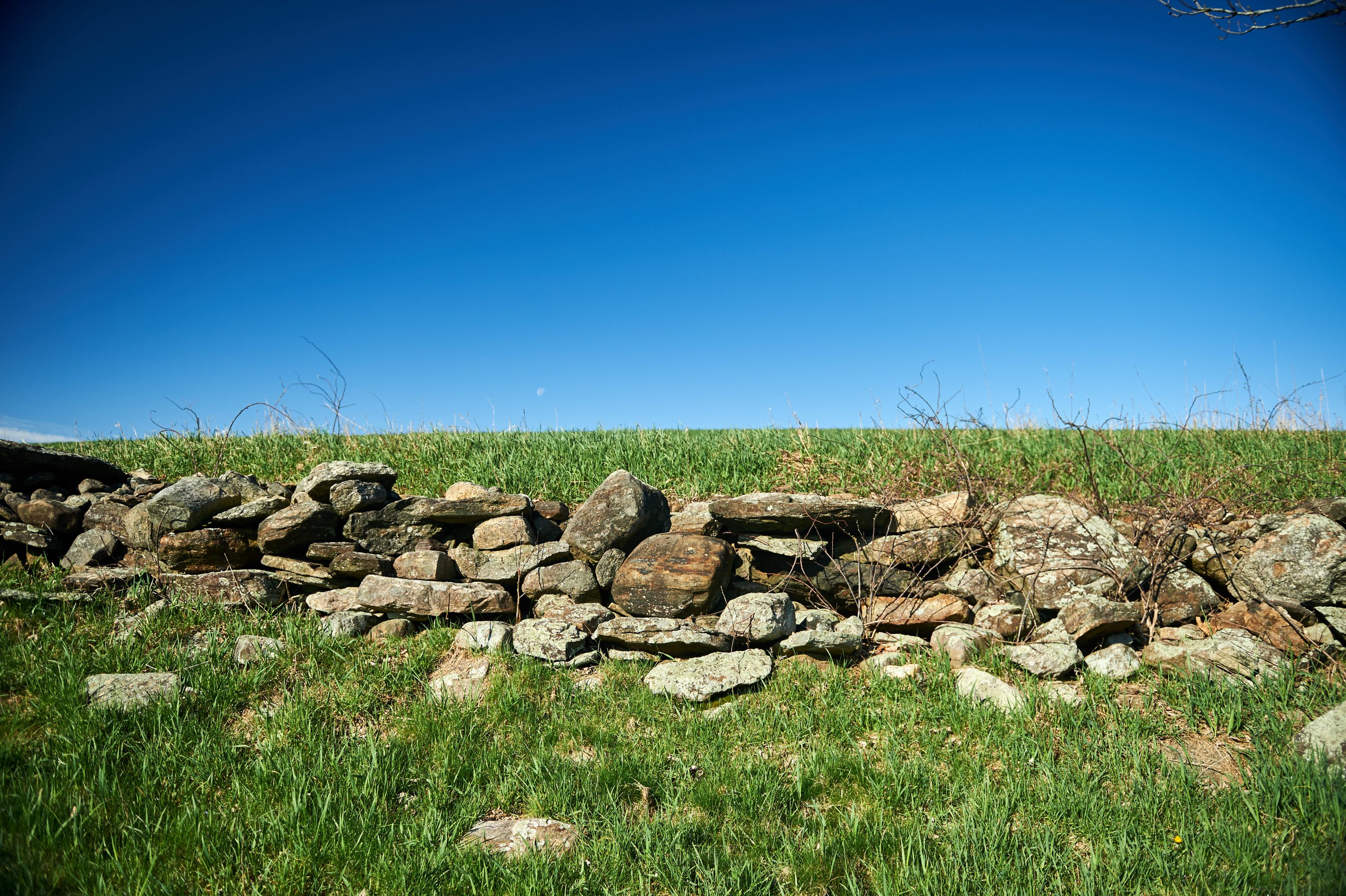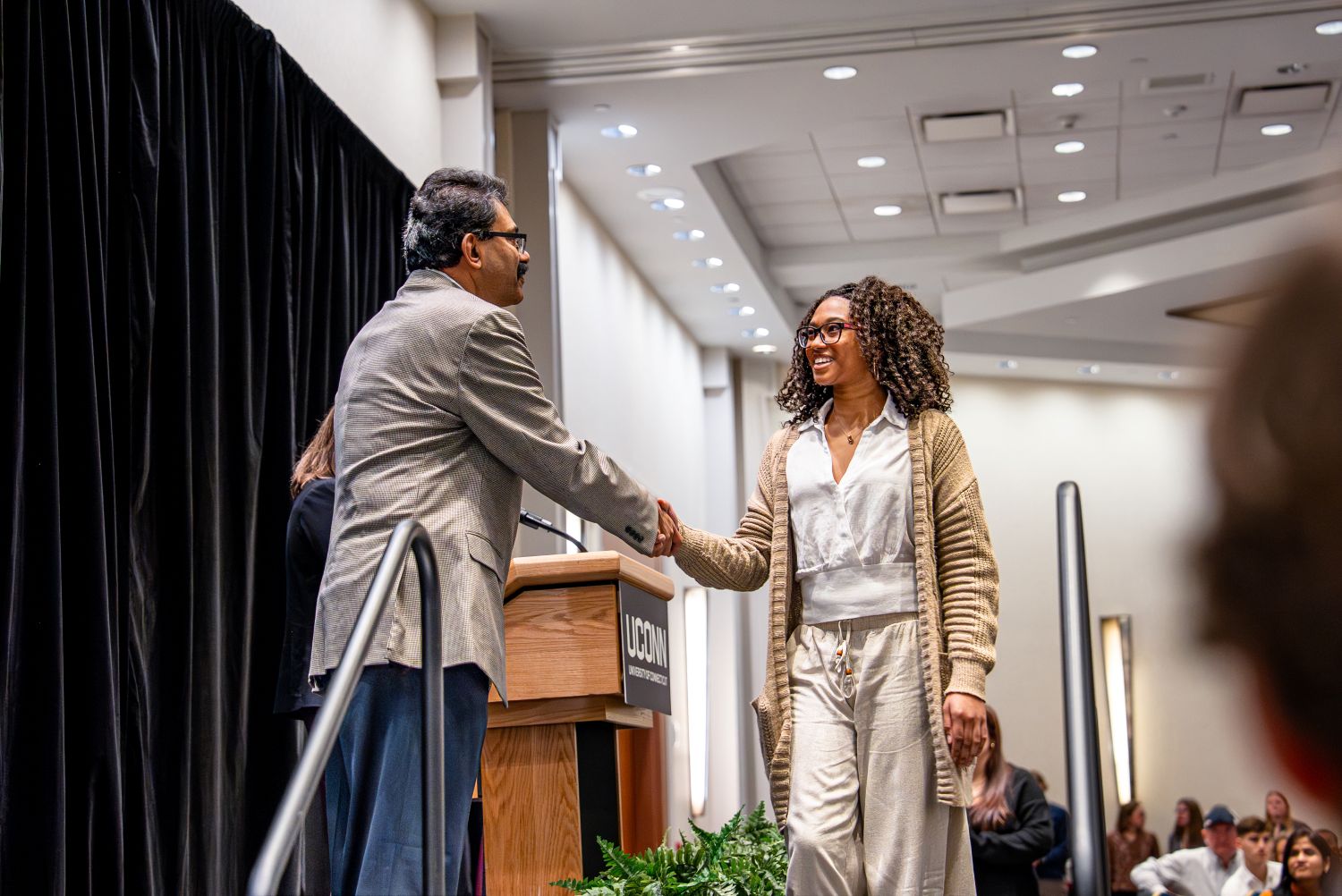To read more stories from the latest edition of UConn Magazine, go to the Magazine website.
Homer Babbidge Jr., a beloved former president of the University of Connecticut, was head-over-heels in love with New England’s historic stone walls.
Or so I heard when I arrived on campus to teach geology in 1984. I heard through the grapevine that during the ’60s, Babbidge required students to build walls in order to graduate … that he taught credit courses on their construction … that this or that was a Babbidge-built wall … and that he left a legacy of materials documenting his efforts in the University archives.
Being curious, I started trying to substantiate these rumors, asking around the Storrs campus during the late 1980s. I remember asking the reference staff of the Babbidge Library to investigate on my behalf. They found nothing. In the mid-1990s, shortly after the Thomas J. Dodd Research Center was up and running, I asked its archivists the same thing. Nothing. When the University’s official history was published in 2006 as Red Brick in the Land of Steady Habits, I searched every page. Nothing. I even asked its lead author, Bruce Stave, if he had run across anything connecting Babbidge and stone walls during his research. Again, nothing.
Gradually and grudgingly, I concluded that the link between Homer Babbidge and New England’s famous stone walls consisted of nothing more than a few just-so stories bundled into oral tradition and crystallized into institutional mythology.
Then, totally out of the blue, I learned that the rumors were true.
‘The land of steady habits’
In 2003, I traveled to Islesboro, Maine, to give a speech on historic stone walls for Jack McConnell. He’s a professional photographer extraordinaire who, while recovering in the hospital from a heart operation, read one of my books and became infected with the stone wall virus. Jack’s reaction was to change his trade name to “Stonewall Jack,” hit the back roads with his camera, print and frame dozens of enlargements, open a gallery for Islesboro’s summer people, and invite me to speak at its grand opening reception. What a wonderful night it was.
One of those summer people in the audience was Alex Babbidge, Homer’s son. The Babbidge family has lived and summered on this beautiful island on the west side of Penobscot Bay since the age of sail, when their family business used clipper ships for the Atlantic trade. For reasons I can’t remember, Alex, Jack, and I ended up on the front porch of the traditional Babbidge family place, eating snacks, drinking cold beer and lemonade, smelling the salt air, and discussing island geology. Waiting for the right moment, I finally asked Alex if the stories about his father’s interest in stone walls were in fact true.
“Yes,” he replied unequivocally, saying he had run across something in the family papers a few years earlier. Before we got down to details, however, we were interrupted by a child needing to be put to bed. As we bid each other a hasty good night, I wondered if I’d ever hear anything more.

Two years whizzed by. Then, in December 2005, I received an unexpected email from long-lost Alex. He had rediscovered the manuscript he had alluded to in Islesboro, and had already popped it in the mail. Within a few days, I was reading the unpublished text of a speech Homer had given to the Monday Evening Club in Hartford on Dec. 3, 1971, during the final phase of his presidency. This civic organization had been operating continuously in Hartford since the first decade of the 19th century, when fieldstone walls were rapidly criss-crossing the agricultural landscape of the new republic.
“How to Build a Stone Wall,” the title of Homer’s speech, was clearly a ruse. His main purpose was to confess – unabashedly – his “love affair with the New England stone wall.” His strong feelings on this subject had been ignited when he was a high school student living in a far-off land devoid of stone walls: Amherst, N.Y. There, he realized how much he missed historic stone walls as an evocation of his New England boyhood and a memorial to the hard work of previous centuries.
During his exile, Homer read and reread a favorite poem, “Mending Wall” by Robert Frost, as a “source of comfort and reassurance.” Homer also recalls a poignant moment during a return to New England after some time away: “Having left the Grand Central Station at dawn, I caught sight of the first stone wall I’d seen in years. I felt I was home again; home in the land of steady habits, a land of ordered, mutually respectful relationships symbolized by those walls.”
A decade later, Homer’s romantic attachment to stone walls was ruptured by none other than Robert Frost himself. As a Yale graduate student, and the youngest fellow of its Pierson College, Homer attended a reading of “Mending Wall” by the elderly poet, then the most senior fellow of the college. Homer listened in “shocked disbelief” while the poet “ridiculed his farm neighbor, as he recited with nothing less than contempt, the line I most revered, ‘good fences make good neighbors.’” Frost, he concluded, wrote the poem as a “trite hand-me-down” to his thoughtless and ignorant neighbor, who epitomized the old Yankee ways in southern New Hampshire.
Homer’s memory of that night lay buried during the transition from University student to University president. “Now another 20 years have passed,” he writes in his speech, “and I still haven’t shaken the effects of that evening. I still grapple, in odd moments, with the elusive ‘elves’ of Mr. Frost’s skepticism, and try to reconcile them with my continuing affection for the stone wall.”
‘I still believe in the stone wall’
By the time he had finished typing his speech, Homer had ironed out the wrinkles of his feelings about stone walls in general and the line “good fences make good neighbors” in particular. After ruminating for a few paragraphs, he concludes: “It seems important, if I am to have my hobby [of building walls] and my conscience, too, that the point be made – at least among friends – that stone walls are not simply or even necessarily, devices for fencing in or fencing out. … The New England stone wall is as nothing more or less than a tidy waste-disposal system.” No longer need they symbolize the “dark and hidden motivation” of excluding neighbors or, worse, of confining one’s self away from significant others. Having found this personal middle ground, he concludes: “At any rate, I think I am now at peace with myself on the subject of stone walls.”
Near the end of his speech, Homer recapitulates by asking: “Is building or mending walls a form of anti-social behavior?” He answers no. Resoundingly so. “I still believe in the stone wall,” he continues, “not to exclude others, but to describe my land, and in doing so, help to define myself.”
Given the speech’s historic context, I strongly suspect that “my land” in the sentence above refers to the campus he presided over. And that the phrase “to define myself” refers in part to the Babbidge presidency. Indeed, with his own hands Homer helped build the University of Connecticut into a modern university by gracing its grounds with walls built from the residue of an earlier era, when Charles and Augustus Storrs were thinking of donating their fields and pastures to the state for use as an agricultural school.
Homer guided the University from 1962 to 1972, a decade of turbulent unrest associated with civil rights, political assassinations, environmental politics, the women’s movement, and the Vietnam War. During this time of profound societal disorder, Homer worked hard to impose architectural order on stone, to transform random fragments of rock into stable and beautiful dry-stone walls. Stonework became a hobby that defined who he was.
His stonework also can be seen as a physical metaphor for the use of his presidential authority to help prevent campus from being heaved apart … whether by frost in the ground or foment in the air. Indeed, the chaos of continuous culture change and of natural soil processes is tireless. For Homer, dry-stone masonry was also a meditation in which muscle, intellect, and soul came together in an outdoor setting.
‘I won’t pick rocks anymore’
To help assuage the unrest of the late ’60s and early ’70s, Homer pulled another trick from his bag. He reached deep into campus history to the year 1899, to a “Victorian version of the student uprising.” This event was a mass campus protest against the requirement that students pick and haul stones and convert them into walls under the pretense of “instructive labor.” This quote – from the desk of the president himself – confirms that wall-building by students was indeed mandatory and therefore required of graduates, whether explicitly or implicitly.
With the New England farm culture in decline, with industrialization accelerating, and with an agricultural school being transformed into an academic college, UConn students simply refused to continue the Neolithic practice of picking stones from farm fields. To rouse the crowd during their protests, they wrote what the campus newspaper called “the most popular song of the day.”
Here are the lyrics from the 1890s, as quoted by Homer in his speech:
A freshman once did come to Storrs
To see what he could see.
But when he saw the rocks that lay
Scattered all over, he swore
As a freshman sometimes will and said
I won’t pick rocks anymore.
And here is the chorus, as published in UConn’s official history:
I won’t pick rocks anymore
I have picked for years
On my father’s farm and
I won’t pick rocks anymore.
The students won their 1899 protest against forced field labor. But physical exercise remained crucial in the minds of educational reformers. UConn athletics – if not born in that moment – surged in importance as a part of campus life. Stretching the truth just a bit, I assert that the conversion of field-picked stone into walls was UConn’s original sport, the foundation of its athletic dynasty.

Homer Daniels Babbidge Jr. established the University of Connecticut Foundation in 1964 to enhance the University’s growth and prestige. He established something else that year as well. Fronting Gulley Hall is the President’s Garden, the aesthetic epicenter of campus (and stop number five on the geologist’s tour of Storrs campus at right). Enclosing that garden is a dappled-gray, lichen-crusted fieldstone wall built in the style of old New England.
So here’s what I’m thinking. During breaks between the slow meetings needed to build the UConn Foundation on paper, Homer went outside to heft stones to help the Horticulture Club build those garden walls. He would have understood that the outward growth and expansion of a modern institution requires a solid inner core tied to the past, especially in a state known as the “Land of Steady Habits.” Perhaps each succeeding UConn president should heft a stone or two, if only to honor this great man’s insight and the plain fact that this great University began as a 19th-century agricultural school.
During his first 20 years at UConn, Thorson taught in the Department of Geology and Geophysics. In 2005, he joined the departments of Ecology and Evolutionary Biology and Anthropology (Archaeology), with major commitments to the Center for Integrative Geosciences and the Honors Program. He is the author of five books, the best-selling Stone by Stone; Stone Wall Secrets; Exploring Stone Walls; Beyond Walden; and Walden’s Shore. To take his interactive walking tour of some geological highlights of the Storrs campus, go to the Magazine website.



